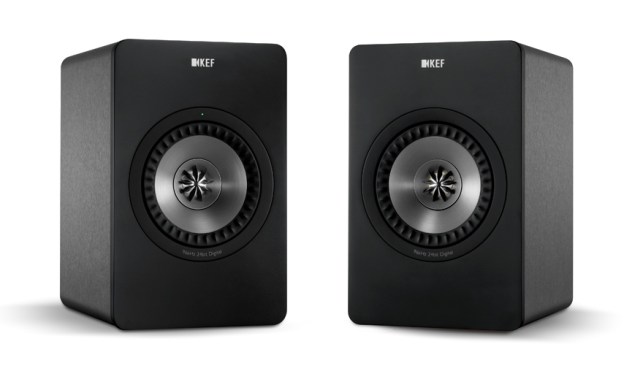 Check out our review of the KEF X300A desktop speakers.
Check out our review of the KEF X300A desktop speakers.
Fifty years is a long time in any industry, but it’s an eternity for an electronics manufacturer. It’s easy to understand why the folks at KEF have been in a party mood for the past 12 months. Its flagship Blade model (which runs a cool $30,000 per pair) utilizes its state-of-the-art Uni-Q drivers. That technology has trickled down to its R-series and can now be found on its LS50 ($1,500) 50th anniversary model, and brand new X300A powered loudspeakers, which, at $800, may be the biggest bargain of all.
Desktop audio has matured a lot in recent years, and it’s easy to spend thousands of dollars on a pair of monitors, amplification, and DAC. Laptops and Mac minis have replaced expensive single-disc players, and – combined with third-party playback software like JRiver Music Center or Pure Music – offer sound quality that mega-buck players used to offer for ten times the price.
Digital audio has taken a quantum leap, and it’s now very possible to build a truly outstanding system for your desktop for under $1,000. KEF, apparently, thinks they can do it for even less.
The heart of the X300A is its Uni-Q single-source driver, which is incredibly lightweight and rigid. The Uni-Q combines a 1-inch aluminum tweeter and 5.25-inch midrange woofer in one driver, offering amazing dispersion. The first thing you notice about the Uni-Q designs is the coherency of the sound – the resolution, clarity, soundstage, and dynamic capabilities are second to none. You may be listening to one driver, but it actually sounds like three or four working together to cover the entire frequency range. Being able to do this in a box that measures 11 inches by 7 inches by 9 inches (HWD), is no small feat.
The X300A powered loudspeakers utilize two class AB 50W/channel audiophile-grade amplifiers that use high performance toroidal transformers to minimize noise and electromagnetic interference. This means that because each driver has an amplifier delivering its own power, the tweeter won’t be negatively affected when the woofers are being driven hard, and won’t sound hard when the woofer is reaching its limit.
KEF has also stuck a rather impressive 24/96 DAC inside the enclosure. When connected to your laptop or desktop computer via USB cable, the DAC will playback HD resolution music files up to 24/96. The X300A also includes a 3.5mm analog input for either an iPod, another DAC via stereo-to-mini cable, or even a phono stage. Yes, you can play your turntable through these and control the volume via the speakers.
If wireless audio is important to you, KEF will send you a free dongle when you register the speakers after purchase (a $99 value). You can stream via AirPlay and it works very well.
The frequency response of the X300As is 58Hz – 28kHz, and, based on our experience with the LS50s, we’re going to give KEF the benefit of the doubt. Depending on the music and how hard you drive the speakers, the X300A placed on your desk (a few inches from the wall is a good idea) will deliver a lot of volume and bass.
The gunmetal finish is a bit industrial looking, but the sound quality is state-of-the-art. For $800, the quality of the entire package makes it the desktop loudspeaker to audition in 2013.


